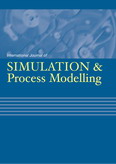Forthcoming Articles
International Journal of Simulation and Process Modelling

Forthcoming articles have been peer-reviewed and accepted for publication but are pending final changes, are not yet published and may not appear here in their final order of publication until they are assigned to issues. Therefore, the content conforms to our standards but the presentation (e.g. typesetting and proof-reading) is not necessarily up to the Inderscience standard. Additionally, titles, authors, abstracts and keywords may change before publication. Articles will not be published until the final proofs are validated by their authors.
Forthcoming articles must be purchased for the purposes of research, teaching and private study only. These articles can be cited using the expression "in press". For example: Smith, J. (in press). Article Title. Journal Title.
 Articles marked with this shopping trolley icon are available for purchase - click on the icon to send an email request to purchase.
Articles marked with this shopping trolley icon are available for purchase - click on the icon to send an email request to purchase.
Online First articles are also listed here. Online First articles are fully citeable, complete with a DOI. They can be cited, read, and downloaded. Online First articles are published as Open Access (OA) articles to make the latest research available as early as possible.
Register for our alerting service, which notifies you by email when new issues are published online.
International Journal of Simulation and Process Modelling (4 papers in press) Regular Issues
Abstract: The growing complexity of software systems poses major challenges for automated testing in continuous integration and continuous delivery pipelines. This paper proposes multi-agent-based software automated testing, a multi-agent reinforcement learning framework that models testing tasks as a decentralized partially observable Markov decision process. Using the Q-network Mixing algorithm, the system enables coordinated decisions across testing agents. Evaluation on a TravisTorrent-based simulation environment shows multi-agent-based software automated testing achieves a 95.2% defect detection rate - showing a 4.7% improvement over the best multi-agent baseline - while reducing test execution time to 70% of conventional rule-based scheduling. Compared with multi-agent deep deterministic policy gradient, it demonstrates a large effect size (Cohen's d=0.89) in defect detection. These results demonstrate the framework's effectiveness in improving testing quality and efficiency, offering a viable solution for intelligent test automation in complex software environments. Keywords: multi-agent reinforcement learning; automated testing; continuous integration and continuous delivery; Jenkins. DOI: 10.1504/IJSPM.2025.10075279
Abstract: This study addresses the critical gap between operational and financial objectives in supply chain inventory management by proposing a novel framework that integrates discrete-event simulation with deep reinforcement learning. We formulate a dual-objective reward function incorporating both traditional costs (holding, shortage, ordering) and the financial metric of cash conversion cycle. Trained and tested on the real-world M5 dataset, our model, cognitive load dynamic assessment model-proximal policy optimization, demonstrates superior performance. Results show it achieves a total cost of 285.4 Keywords: supply chain finance; deep reinforcement learning; inventory optimization; cash conversion cycle; M5 dataset. DOI: 10.1504/IJSPM.2025.10075344
Abstract: Automated generation of physically plausible 3D environments is a key challenge in digital twins, the metaverse, and robot simulation. Current methods focus mainly on visual fidelity, often overlooking functional and physical rationality, limiting direct applicability to simulation tasks. To address this, we propose a multimodal Transformer-based framework for environment design generation and consistency simulation. Utilizing a cross-modal attention mechanism, our model integrates textual descriptions with prior knowledge from real 3D scenes. It incorporates fine-grained physical constraint losses including collision avoidance, support relations, and spatial accessibility optimisation during training to explicitly model physical consistency. Experiments on the Matterport3D dataset show our method outperforms existing baselines in visual quality and layout rationality. Notably, it shows significant gains in physical consistency: collision volume is greatly reduced, and navigation success reaches 89%, affirming high simulability and practicality of the generated environments. Keywords: multimodal transformer; environment design generation; physical consistency; simulation modeling; microphysically constrainable. DOI: 10.1504/IJSPM.2026.10075345 Simulation-driven deep learning framework for early poultry disease detection using faecal image classification with optimised CNN architectures  by Nonita Sharma, Monika Mangla, Manik Rakhra, Baljinder Kaur, Raj Kumar Mohanta, Bijay Kumar Paikaray Abstract: The present investigation aims to devise an optimized Convolutional Neural Network (CNN) framework to identify prominent poultry diseases based on faecal images. The proposed research model uses a tri-convolutional layer architecture to enhance the accuracy of poultry disease classification and improve feature extraction. Three major diseases, namely coccidiosis, salmonella, and Newcastle, have been considered. The prime objective of current research is to achieve early detection by employing advanced deep-learning techniques. The proposed model uses fecal images to identify pathological conditions using the TriConvLayer architecture accurately. In this work, custom CNN models, viz. SoloConvLayer, TriConvLayer, and FiveConvLayer models are used to achieve an accuracy of 97%, 98%, and 98%, respectively. The achieved result advocates the efficacy of the proposed approach. It thus has the potential to revolutionize early disease detection in poultry farming, a major step towards improving animal health and farm productivity. Keywords: deep learning; poultry disease detection; convolutional neural networks; CNN; faecal image analysis; poultry health monitoring; disease classification; simulation framework. DOI: 10.1504/IJSPM.2025.10073525 |
 Open Access
Open Access